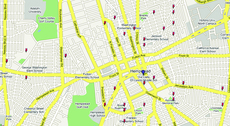By Rebecca Miller
Students should think twice before heading out on foot around the University as they may be brushing shoulders with one of the 40 registered sex offenders living less than three miles from campus.
A first-degree sex offender lives approximately 0.8 of a mile from the University, according to a list from the State Division of Criminal Justice Service. He is the closest of the 40 registered offenders. This 29-year-old male was convicted on charges of first-degree sexual abuse of a 14-year-old girl and was incarcerated for about a year. After his term, he moved to Hempstead.
The Criminal Justice Web site reports that there are currently 461 registered sex offenders living in Nassau County.
Many factors are considered when choosing a college to attend and one of the major contributors for parents and students is safety.
“It would play a big part of my decision in choosing a school,” Deanna Caiati, a junior marketing major, said. However, the University does not publicize the sex offender statistics. It does release an annual Campus Safety report, which includes the statistics of crime throughout the past three years. These reports are useful to college and high school students when considering a safe university to attend.
Third degree sex offenders are the most dangerous and the most likely to relapse, according to the New York State Division of Criminal Justice Service Web site. This site is an informative tool for finding the locations of sex offenders as it provides detailed descriptions of their appearance, as well as the crimes they have committed.
The nearest third degree sex offender lives about 1.7 miles from the University and was convicted on charges of rape of a 30-year-old female. The unique aspect of the restraints on this particular individual is that he is not permitted to have a driver’s license or operate a motor vehicle. To travel, this offender is limited to walking and public transportation. His surrounding area is the University where many students who live off campus walk to class each day.
Despite the University’s complimentary bus service and public safety’s transportation service, students often resort to walking home from bars in the early hours of the morning and to their dorm rooms or off-campus residences after evening classes.
Linda Evans, an adjunct associate marketing professor, thinks that many students believe that it will never happen to them until it is too late
“College students have a feeling of immortality,” Evans said.
It is up to the local town officials to send out notifications of the presence of registered sex offenders. However, some University students say that they have never been notified about these neighbors and should be informed about registered sex offenders living in such close proximity.
“If we’re paying so much for tuition we should also be notified about the dangers of the University,” Faheem Mahmud, a senior finance major, said.
Senior Milan Kowalewski said that he believes that people know that Hempstead is a very unsafe area and need to take precautions.
“People have to take responsibility for their selves,” Kowalewski said.
Megan’s Law requires all states to develop a procedure for notifying residents about sex offenders living in the area. It was implemented after a 7-year-old girl was lured into the home of a two-time registered sex offender who lived across a street from her. He raped, strangled and suffocated her. Her murderer was sharing his home with two other convicted sex offenders whom he met in prison.
In March 2002, Gov. George Pataki signed an amendment to New York’s Megan’s Law that requires that the N.Y. State Division of Criminal Services notify any university police department if a registered sex offender enrolls or is employed at the institution. Such information is required to be documented and strategically located on postings throughout the campus, as well as in e-mail alerts to the college community.
According to a recent Newsday article, Hempstead is home to the second largest number of registered level two to three sex offenders in a one-mile radius. The article also explained that the concentration of sex offenders living within the community of the University is because many offenders require housing assistance and the country’s Department of Social Services clusters offenders in the few places where housing is available.
The University Department of Public Safety ensures students safety by monitoring the campus on a 24-hour basis and reporting events. When students step off the boundaries of the University, however, it is up to them to keep their eyes open and be prepared for what may disrupt their stroll through Hempstead.

Rectangular tags indicate areas near University where sex offenders reside. (courtesy www.mapsexoffenders.com)
